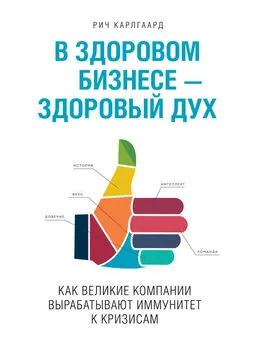Рич Карлгаард - Поздний расцвет [Как взрослым добиться успеха в мире, одержимом ранним развитием] [litres]
- Название:Поздний расцвет [Как взрослым добиться успеха в мире, одержимом ранним развитием] [litres]
- Автор:
- Жанр:
- Издательство:Литагент 5 редакция «БОМБОРА»
- Год:2020
- Город:Москва
- ISBN:978-5-04-102266-2
- Рейтинг:
- Избранное:Добавить в избранное
-
Отзывы:
-
Ваша оценка:
Рич Карлгаард - Поздний расцвет [Как взрослым добиться успеха в мире, одержимом ранним развитием] [litres] краткое содержание
Поздний расцвет [Как взрослым добиться успеха в мире, одержимом ранним развитием] [litres] - читать онлайн бесплатно ознакомительный отрывок
Интервал:
Закладка:
21. Я лично могу подтвердить силу внутреннего диалога – Shahzad Tahmasebi Boroujeni and Mehdi Shahbazi, “The Effect of Instructional and Motivational Self-Talk on Performance of Basketball’s Motor Skill,” Procedia – Social and Behavioral Sciences 15 (2011): 3113–17; Judy L. Van Raalte et al., “Cork! The Effects of Positive and Negative Self-Talk on Dart Throwing Performance,” Journal of Sport Behavior 18, no. 1 (1995): 50; Jennifer Cumming et al., “Examining the Direction of Imagery and Self-Talk on Dart-Throwing Performance and Self-Efficacy,” Sport Psychologist 20, no. 3 (2006): 257–74; Antonis Hatzigeorgiadis et al., “Self-Talk and Sports Performance: A Meta-Analysis,” Perspectives on Psychological Science 6, no. 4 (2011): 348–56; Judy L. Van Raalte et al., “The Relationship Between Observable Self-Talk and Competitive Junior Tennis Players’ Match Performances,” Journal of Sport and Exercise Psychology 16, no. 4 (1994): 400–15; Christopher P. Neck et al., “ ‘I Think I Can; I Think I Can’: A Self-Leadership Perspective Toward Enhancing Entrepreneur Thought Patterns, Self-Efficacy, and Performance,” Journal of Managerial Psychology 14, no. 6 (1999): 477–501; Antonis Hatzigeorgiadis et al., “Investigating the Functions of Self-Talk: Te Effects of Motivational Self-Talk on Self-Efficacy and Performance in Young Tennis Players,” Sport Psychologist 22, no. 4 (2008): 458–71; Eleni Zetou et al., “The Effect of Self-Talk in Learning the Volleyball Service Skill and Self-Efficacy Improvement,” Journal of Sport and Human Exercise 7, no. 4 (2012): 794–805; Chris P. Neck and Charles C. Manz, “Thought Self-Leadership: The Influence of Self-Talk and Mental Imagery on Performance,” Journal of Organizational Behavior 13, no. 7 (1992): 681–99; Robert Weinberg, Robert Grove, and Allen Jackson, “Strategies for Building Self-Efficacy in Tennis Players: A Comparative Analysis of Australian and American Coaches,” Sport Psychologist 6, no. 1 (1992): 3–13; Daniel Gould et al., “An Exploratory Examination of Strategies Used by Elite Coaches to Enhance Self-Efficacy in Athletes,” Journal of Sport and Exercise Psychology 11, no. 2 (1989): 128–40. 179 Why am I so scared?: Elizabeth Bernstein, “ ‘Self Talk’: When Talking to Yourself, the Way You Do It Makes a Difference,” Wall Street Journal, May 5, 2014; Kristin Wong, “The Benefits of Talking to Yourself,” New York Times, June 8, 2017. См. также Ethan Kross et al., “Self-Talk as a Regulatory Mechanism: How You Do It Matters,” Journal of Personality and Social Psychology 106, no. 2 (2014): 304.
22… «обеспечить себе объективную и полезную обратную связь» – Bernstein, “ ‘Self Talk.’ ”
23. «Убежденнность усиливает вашу уверенность в себе…» – Bandura, “Self-Efficacy: Toward a Unifying Theory of Behavioral Change”; Bandura, “Self-Efficacy Mechanism in Human Agency.”
24… называют «сменой восприятия», или обрамлением – Amy C. Edmondson, “Framing for Learning: Lessons in Successful Technology Implementation,” California Management Review 45, no. 2 (2003): 34–54. See also Amos Tversky and Daniel Kahneman, “The Framing of Decisions and the Psychology of Choice,” Science 211, no. 4481 (1981): 453–58.
25… такая же рамка, только когнитивная, и она формирует наше поведение… – Robert M. Entman, “Framing: Toward Clarification of a Fractured Paradigm,” Journal of Communication 43, no. 4 (1993): 51–58; Robert D. Benford and David A. Snow, “Framing Processes and Social Movements: An Overview and Assessment,” Annual Review of Sociology 26, no. 1 (2000): 611–39; George Lakoff, “Simple Framing,” Rockridge Institute 14 (2006).
26… воспринимать волнение как возбуждение, энтузиазм – Alison Wood Brooks, “Get Excited: Reappraising Pre-Performance Anxiety as Excitement,” Journal of Experimental Psychology: General 143, no. 3 (2014): 1144.
27. Брукс обнаружила, что мы можем почувствовать возбуждение вместо волнения … – Maxie C. Maultsby, Jr., Rational Behavior Therapy (Appleton, WI: Rational, 1990).
28. В большинстве психологических исследований используют противоположные модели обрамления… – Carol S. Dweck and Ellen L. Leggett, “A Social-Cognitive Approach to Motivation and Personality,” Psychological Review 95, no. 2 (1988): 256.
29… эффективная смена восприятия проблемы чрезвычайно важна… – Amy C. Edmondson, Teaming: How Organizations Learn, Innovate, and Compete in the Knowledge Economy (Hoboken, NJ: John Wiley & Sons, 2012); Amy C. Edmondson, Richard M. Bohmer, and Gary P. Pisano, “Disrupted Routines: Team Learning and New Technology Implementation in Hospitals,” Administrative Science Quarterly 46, no. 4 (2001): 685–716; Chris Argyris and Donald A. Schön, “Organizational Learning: A Theory of Action Perspective,” Reis, nos. 77–78 (1997): 345–48.
30… развивать самосострадание … – Laura K. Barnard and John F. Curry, “Self-Compassion: Conceptualizations, Correlates, and Interventions,” Review of General Psychology 15, no. 4 (2011): 289.
31. «В целом, результаты этих исследований наводят на мысль…» – Mark R. Leary et al., “Self-Compassion and Reactions to Unpleasant Self-Relevant Events: The Implications of Treating Oneself Kindly,” Journal of Personality and Social Psychology 92, no. 5 (2007): 887.
32. Самосострадание к себе тесно связано с эмоциональной гибкостью… – Laura K. Barnard and John F. Curry, “Self-Compassion: Conceptualizations, Correlates, and Interventions,” Review of General Psychology 15, no. 4 (2011): 289.
33. Это качество согласуется с показателями эмоционального благополучия … – Kristin D. Neff, Stephanie S. Rude, and Kristin L. Kirkpatrick, “An Examination of Self-Compassion in Relation to Positive Psychological Functioning and Personality Traits,” Journal of Research in Personality 41, no. 4 (2007): 908–16; Filip Raes, “The Effect of Self-Compassion on the Development of Depression Symptoms in a Non-Clinical Sample,” Mindfulness 2, no. 1 (2011): 33–36.
34… сострадание к себе усиливает мотивацию … – Juliana G. Breines and Serena Chen, “Self-Compassion Increases Self-Improvement Motivation,” Personality and Social Psychology Bulletin 38, no. 9 (2012): 1133–43; Jeannetta G. Williams, Shannon K. Stark, and Erica E. Foster, “Start Today or the Very Last Day? The Relationships Among Self-Compassion, Motivation, and Procrastination,” American Journal of Psychological Research 4, no. 1 (2008).
35. « Когда вы идете в бой, кого вы хотите видеть рядом – врага или союзника?» – Kristin Neff, “The Space Between Self-Esteem and Self-Compassion: Kristin Neff at TEDx CentennialParkWomen,” YouTube, February 6, 2013, http://bit.ly/2xyNLRV.
36. «Сострадание к себе означает…» – Kristin Wong, “Why Self-Compassion Beats Self-Confidence,” New York Times, December 28, 2017.
37. Мировые консалтинговые компании… – McKinsey & Company”: Robert I. Sutton, “Why Good Bosses Tune In to Their People,” McKinsey Quarterly, August 2010, https://mck.co/2MONArc; Antonio Feser, Nicolai Nielsen, and Michael Rennie, “What’s Missing in Leadership Development?” McKinsey Quarterly, August 2017, https://mck.co/2PPw08f; Bernadette Dillon and Juliet Bourke, “Te Six Signature Traits of Inclusive Leadership: Thriving in a Diverse New World,” DeLoitte Insights, April 14, 2016, http://bit.ly/2OC9a3Y.
1… «менталитет краба»… – Carliss D. Miller, “A Phenomenological Analysis of the Crabs in the Barrel Syndrome,” Academy of Management Proceedings 2015, no. 1 (2015); Carliss D. Miller, “The Crabs in a Barrel Syndrome: Structural Influence on Competitive Behavior,” Academy of Management Proceedings 2014, no. 1. (2014).
2. «Любые вещи я рассматривал с точки зрения статуса…» – Tom Wolfe quoted in David A. Price, “Where Tom Wolfe Got His Status Obsession,” Nieman Storyboard, July 5, 2016, http://bit.ly/2xbQdh6.
3. «Вы экстраверт или интроверт?…» – Todd Rose, The End of Average: How We Succeed in a World Tat Values Sameness (New York: HarperCollins, 2015).
4… резко снизилась мобильность в географическом плане … – Richard Fry, “Americans Are Moving at Historically Low Rates, in Part Because Millennials Are Staying Put,” Pew Research Center, February 13, 2017, https://pewrsr.ch/2DdAXX2.
5. Разве я могла написать книгу … – Kimberly Harrington, интервью автору в 2018 году.
6… реже меняют работу из-за неудовлетворенности самой деятельностью … – Daniel M. Cable and Timothy A. Judge, “Person-Organization Fit, Job Choice Decisions, and Organizational Entry,” Organizational Behavior and Human Decision Processes 67, no. 3 (1996): 294–311.
7… одни люди выносливы от природы … – Susan Cain, Quiet: The Power of Introverts in a World Tat Can’t Stop Talking (New York: Broadway Books, 2013).
8. …«высокореактивными» малышами .. – Jerome Kagan, Galen’s Prophecy: Temperament in Human Nature (New York: Basic Books, 1998).
9… чаще страдали от депрессии … – David Dobbs, “The Science of Success,” Atlantic, December 2009, http://bit.ly/2pc8tmS. For Belsky’s work, see Jay Belsky et al., “Vulnerability Genes or Plasticity Genes?” Molecular Psychiatry 14, no. 8 (2009): 746; Michael Pluess and Jay Belsky, “Differential Susceptibility to Rearing Experience: The Case of Childcare,” Journal of Child Psychology and Psychiatry 50, no. 4 (2009): 396–404; Michael Pluess and Jay Belsky, “Differential Susceptibility to Parenting and Quality Child Care,” Developmental Psychology 46, no. 2 (2010): 379; and Jay Belsky and Michael Pluess, “Beyond Diathesis Stress: Differential Susceptibility to Environmental Influences,” Psychological Bulletin 135, no. 6 (2009): 885.
10. Квентин Харди, мой бывший коллега… – Hardy was Forbes Media’s San Francisco bureau chief in the early 2000s.
11. «… Настоящая работа «Saddleback »…» – Rick Warren, интервью автору в 2004 году.
12… люди, которые могут нагляднее представить «будущего себя» … – Hal E. Hershfeld et al., “Increasing Saving Behavior Trough Age-Progressed Renderings of the Future Self,” Journal of Marketing Research 48 (2011): S23–S37; Hal Ersner Hershfeld et al., “Don’t Stop Thinking About Tomorrow: Individual Differences in Future Self-Continuity Account for Saving,” Judgment and Decision Making 4, no. 4 (2009): 280; Hal Ersner Hershfeld, G. Elliott Wimmer, and Brian Knutson, “Saving for the Future Self: Neural Measures of Future Self-Continuity Predict Temporal Discounting,” Social Cognitive and Affective Neuroscience 4, no. 1 (2008): 85–92; Hal E. Hershfeld, “Future Self-Continuity: How Conceptions of the Future Self Transform Intertemporal Choice,” Annals of the New York Academy of Sciences 1235, no. 1 (2011): 30–43; Hal E. Hershfeld, Taya R. Cohen, and Leigh Tompson, “Short Horizons and Tempting Situations: Lack of Continuity to Our Future Selves Leads to Unethical Decision Making and Behavior,” Organizational Behavior and Human Decision Processes 117, no. 2 (2012): 298–310; Jean-Louis Van Gelder et al., “Friends with My Future Self: Longitudinal Vividness Intervention Reduces Delinquency,” Criminology 53, no. 2 (2015): 158–79.
Читать дальшеИнтервал:
Закладка:
![Обложка книги Рич Карлгаард - Поздний расцвет [Как взрослым добиться успеха в мире, одержимом ранним развитием] [litres]](/books/1070509/rich-karlgaard-pozdnij-rascvet-kak-vzroslym-dobit.webp)






![Жанна Сио-Фашен - Сверходаренный ребенок [Как понять его и помочь добиться успеха] [litres]](/books/1066227/zhanna-sio.webp)


![Брэд Сталберг - Гори, но не сгорай. Как пойти ва-банк, добиться успеха и наслаждаться жизнью без баланса [litres]](/books/1147482/bred-stalberg-gori-no-ne-sgoraj-kak-pojti-va.webp)